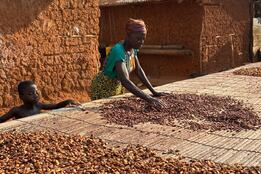Since 2011, the Democratic Republic of Congo (DRC) has deployed $65 million in funding from the Climate Investment Funds (CIF) to protect the country’s forests. In December 2024, stakeholders met in the capital, Kinshasa, to close out DRC’s investment plan and take stock of results.
The 3-day workshop gathered experts from the World Bank and the African Development Bank, CIF’s implementing partners in the country, as well as government officials, civil society, and project beneficiaries. Participants travelled, sometimes for several days, to join from the various project areas in Maï-Ndombe, Kongo Central, Mbuji-Mayi, Kananga, and Kisangani.
The group reviewed CIF's Forest Investment Program (FIP) results in DRC: the country is home to 60% of the Congo Basin forests, is the world's largest carbon sink, and one of Africa's poorest countries. There, wood is frequently used as the primary source of energy for cooking by a rapidly growing population. This practice is a major driver of deforestation, releases carbon dioxide into the atmosphere, and poses health risks, particularly to women and children. With CIF funding, the government and its partners adopted a comprehensive approach to addressing this issue and other root causes of deforestation - from forests to urban areas.
31 million tCO2 eq reduced
First, participants discussed how FIP advanced DRC’s national REDD+ strategy from preparation to investment phase, leading to the country's first emissions reduction payments. Overall, the program resulted in 31 million tCO2 eq reduced or avoided before 2034 – or 6.5 million cars off the road for one year. The most significant greenhouse gas mitigation impacts were achieved through sustainable forest management, afforestation, and agroforestry pilots.
Improved livelihoods for more than 421,000 people
Beyond climate action, strategies such as the development of agroforestry, sustainable value chains, and payments for environmental services yielded substantial economic value for more than 421,000 people. One of the workshop participants, farm-owner Henri Fuala, switched to agroforestry with FIP support. He reported clear improvements in productivity and income, as well as biodiversity co-benefits. “Beforehand, my farm was a savanna, now I have a forest landscape. I can see the wildlife coming back – guinea fowls, antelopes, birds – the changes are visible. I now have caterpillars and mushrooms that come on the trees and that we can eat. This is a much better system.”
90,000 improved cookstoves delivered
Urban entrepreneurs also participated in the program, manufacturing, marketing, and distributing fuel-efficient cookstoves. These stoves reduce household air pollution, cut emissions and wood usage by almost 30%, and lessen health risks and forest pressure. The program made progress in encouraging private sector participation and market creation in the fuelwood supply chain, including through the establishment of the National Alliance for Improved Cookstoves; the involvement of seven companies in the improved cookstove market; and the delivery of nearly 90,000 improved cookstoves to urban customers, and counting.
Empowered Indigenous Peoples and Local Communities
In forest areas, Indigenous Peoples and local communities partnered directly with CIF’s Dedicated Grant Mechanism (DGM) to sustainably manage their land. DGM proved transformative in building capacity and creating networks among Indigenous Peoples and local communities to consolidate their rights and strengthen their participation in sustainable forest management. The program reached nearly 29,000 direct beneficiaries, such as Julie Ndoole (image below), a Pygmy community member from Walikale. “With this project we were able to find more revenues, for example we cultivate the land,” she explained. “After the project, the mothers could find ways to feed their families, put kids in school, and find soap. It went well.”
Workshop participants agreed that DGM also generated momentum for a 2022 law recognizing the rights of Indigenous Pygmy peoples, on top of support to obtain perpetual titles for more than 252,000 ha of land. DGM also advanced education programs focused on women’s literacy and enabled the implementation of micro-projects.
Yannick Lwanba, Monitoring and Evaluation Lead for FIP DRC, concluded the workshop by noting the program’s role in influencing forest conservation strategies and bringing more investments: "The CIF was designed as a lever to enable DRC to capture climate financing. To date, we can say that this objective has been achieved. (…) We went from $60 million to more than $500 million in less than ten years. The CIF has made it possible to demonstrate certain approaches on the ground that have encouraged technical and financial partners to adopt and support these approaches. Today, all the sectoral programs that are developed use the approaches initiated by FIP.”




